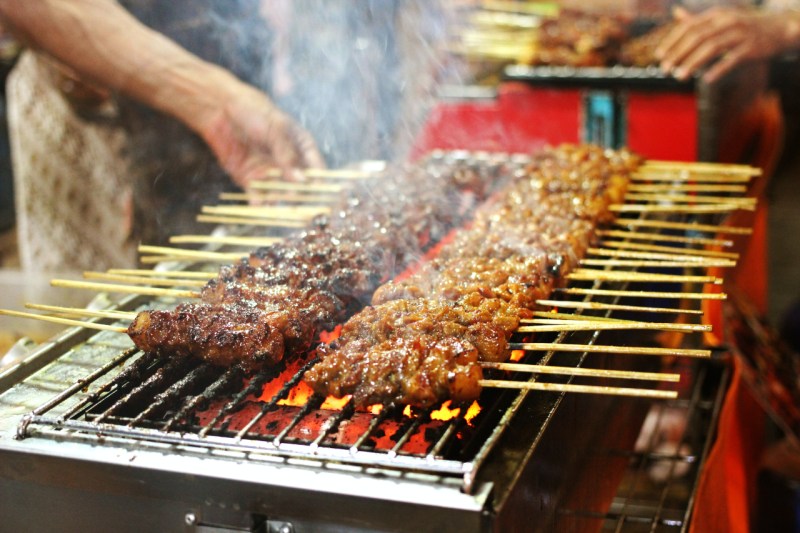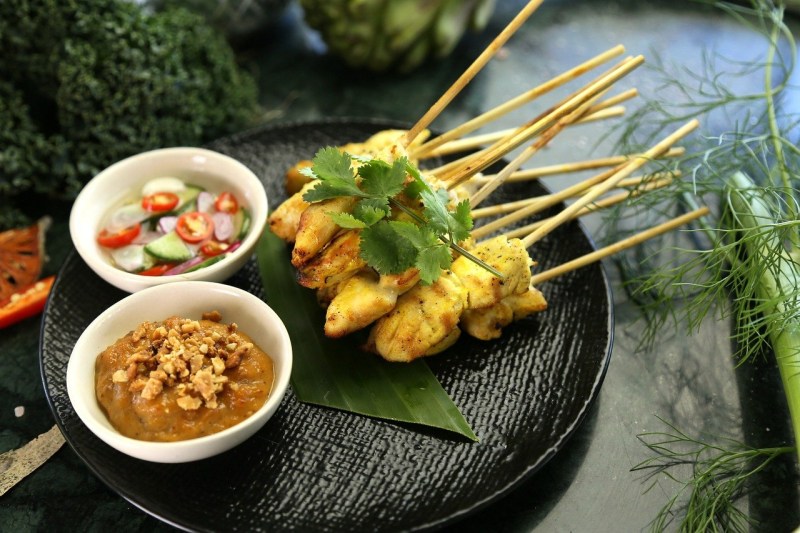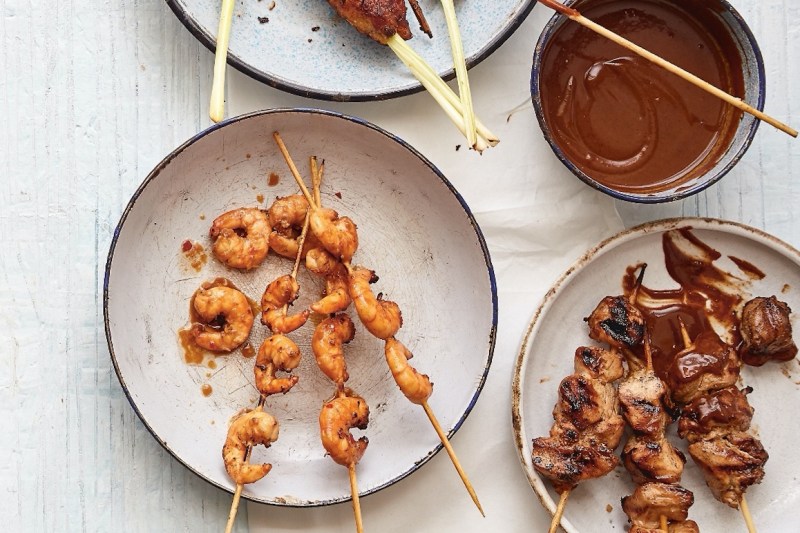
Small, smoky sticks of flame-licked meat, there’s perhaps no grilled item more beloved throughout Southeast Asia than satay. These meat skewers are diverse, ranging from goat to chicken, and are equally popular as a snack or meal. Although satay can be found in Indonesia, Malaysia, and Thailand, its origins hail from the Middle East. During the 8th century, Muslim merchants brought kebabs to the Indonesian island of Java. Since those ancient times, satay has evolved, adapting to the rich culinary landscape and local ingredients of Southeast Asia.
Related Guides
Regional Variations

Because satay has spread across the diverse landscape of Southeast Asia, there are now countless regional variations of these skewers. In Java, Indonesia, satay (or sate as it’s known in Indonesia) is traditionally made from beef, lamb, or goat. Known as sate kambing (goat or lamb), this version features a tart and fragrant blend of tamarind and ginger, a perfect complement to the strong flavors of goat or mutton. In Thailand, satay often features coconut milk and pork, an uncommon ingredient in the majority of Muslim countries of Indonesia and Malaysia. On the coasts, seafood satays are widespread, such as Singapore satay udang, made with shrimp in a ginger paste, and satay lilit of Bali, Indonesia, featuring chunks of tuna seasoned with spices. Finally, there’s chicken, which can be found throughout Southeast Asia. Satay ayam, a Malaysian style of chicken satay is marinated in a blend of spices including ginger and coriander.
Read more: Best Charcoal Grills
How to Eat Satay
While satay is already flavor-packed, the skewers are often served with a variety of sauces and condiments. In Indonesia and Malaysia, satay will commonly be served on a banana leaf with a rich peanut sauce and sambal kecap, a syrup-like sweet soy sauce packed with raw chilis and shallots. Besides sauces, pickled vegetables are another common accompaniment. The refreshing bite of sweet and sour pickles is a welcome palate cleanser for grilled meats. These pickles can include Indonesian sweet and tart acar timun or a Thai-style salad of cucumbers with shallots and chilis.
The most famous accompaniment of satay is peanut sauce. A far cry from standard American peanut butter, satay peanut sauce is made with peanuts caramelized with palm sugar, pungent shrimp paste, and citrus. Peanut sauce is served in generous quantities with satay so free feel to pour it on.
Indonesian Chicken Sate

Makes 12 skewers
(By Eleanor Ford, cookbook author and chef)
Eleanor Ford is the celebrated cookbook author of Samarkand, named a book of the year by The Guardian and Food52’s Piglet. It was also awarded the 2017 ‘Food and Travel’ prize by The Guild of Food Writers. Her latest cookbook is , which focuses on the cuisine of Indonesia. Fire Islands has won best ‘International or Regional Cookbook’ at The Guild of Food Writers Awards 2020, two Gourmand World Cookbook Awards 2020, bronze at the German Cookbook Awards, and ‘Food and Drink Book of the Year’ 2020 at the Edward Stanford Travel Writing Awards, which celebrates world-class travel writing.
Ingredients:
- 14 oz skinless chicken breast
- 1 garlic clove, roughly chopped
- 1 tbsp kecap manis
- oil, for grilling
- juice of ½ lime, to serve
- Peanut sauce, warmed
Method:
- Cut the chicken into 1-inch cubes. Mix with the garlic, kecap manis, and a pinch of salt. Set aside to marinate for 10 minutes (or if longer, cover and keep in the fridge).
- If using bamboo skewers, soak in water to stop them from burning whilst the meat marinates. Thread the chicken onto the skewers, keeping the pieces tightly packed together.
- The best results are indisputably on a barbecue — add coconut fibers or wood chips for the wonderful smoky notes — but you could also grill or griddle on high heat.
- When searing hot, brush your grill with a little oil and cook your sate over direct heat (keeping the sticks away from the coals). Turn until browned on all sides and cooked through.
- Spritz the lime juice over the sate and douse with the warm peanut sauce.
Read more: How to Grill Chicken
Peanut sauce
Ingredients:
- ₂ ∕₃ cup raw peanuts, skin on
- 1 tbsp oil, for frying peanuts
- 1 garlic clove, crushed
- ½ tsp shrimp paste, toasted (optional)
- ½ tsp dark palm sugar (gula jawa), grated
- 3 tbsp kecap manis
- juice of ½ a lime
Method:
- Fry the peanuts to bring out their toasty flavor.
- Heat the oil in a wok or frying pan over high heat. When simmering, add the peanuts and stir-fry for a minute. Reduce the heat to medium and continue to fry, stirring often, for about 5 minutes, until the nuts are a deep golden brown. Remove with a slotted spoon and drain on a paper towel.
- Tip the nuts into a food processor (keep the skins on) with the garlic, shrimp paste, palm sugar, and a good pinch of salt. Blitz to sandy rubble, then scrape the sides and process for another minute. Continue scraping and blitzing for a few minutes at a time until you have a smooth purée (it should get there, with some perseverance).
- Transfer the peanut butter to a saucepan, add the kecap manis and a small glassful of water. Cook over medium-high heat, stirring often until you have a sauce that is dark and slightly sticky. Thin with more water if it gets too thick — you want it to thickly coat the sate but be just pourable.
- Leave to cool and taste for seasoning, adjusting the saltiness and sweetness if you like. A final spritz of lime juice will brighten the flavors.
Editors' Recommendations
- How to make soubise, a 3-ingredient onion sauce for grilled meat
- How to Make Smoked Thanksgiving Side Dishes
- How To Make a Velvety Smooth Bearnaise Sauce
- How To Make a Killer Meatloaf (It’s Easier Than You Think)
- How To Cook a Delicious Meat Sauce From Scratch




